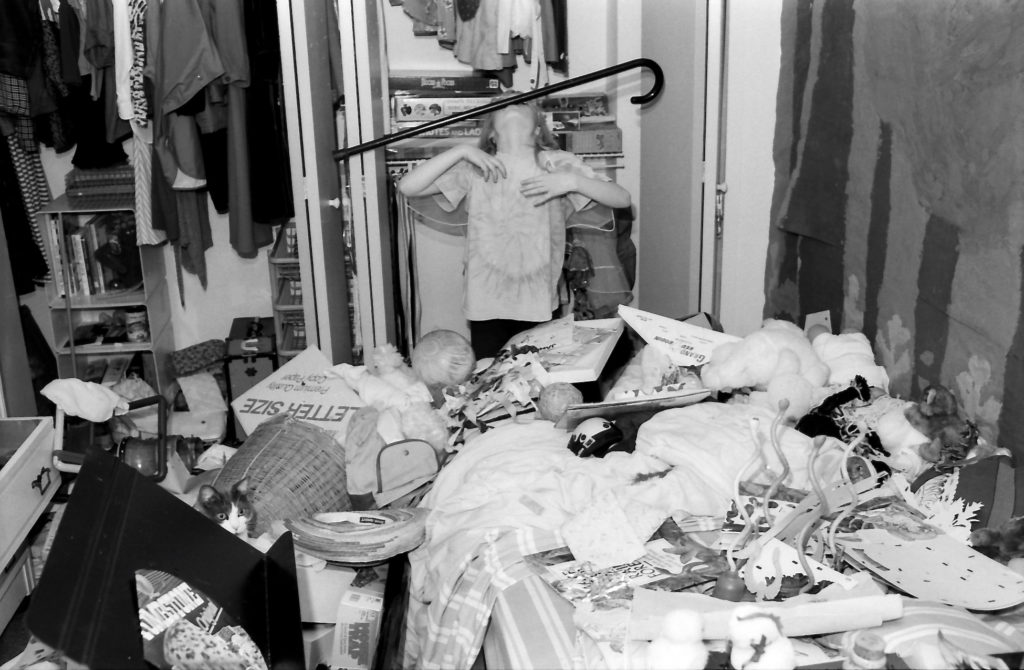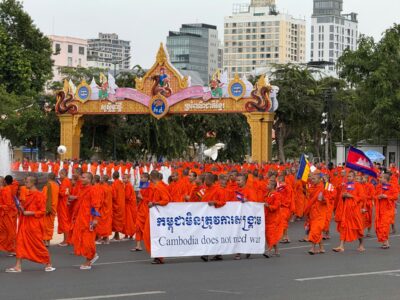
Age nine, I am joyous and defiant, performing a trick for the camera. I had begun to clean my room when I became diverted. The closet is free of clutter only because I emptied its contents onto the floor. In the morass can be made out a painting of the rainforest, a doll’s face, bongos, and some worrisome ephemera like frozen pizza packaging and a paper wrapper from the dry cleaners. The cat, bottom left, looks slightly stunned about this unexpected chaos. A couple of decades on, I have to regard this photograph like evidence in a case history, an early sign of a lifelong attachment to objects that is occasionally disruptive of adult life. While I am no longer quite so jubilantly messy, I have always had trouble putting my things in order. Stuff tends to accumulate to me and I find it vaguely painful to throw things away.
The Japanese lifestyle guru Marie Kondo wrote a bestselling book to help people like me. It is called The Life-Changing Magic of Tidying Up. By now, many are familiar with the rudiments of her technique, the KonMari Method. It is a kind of spiritual exercise for self-improvement through clearing out piles of varia. You take each of your possessions, one by one, into your hands. You pause for a few seconds to gauge how your body reacts. If the object fails to “spark joy” then it must be discarded.
Kondo puts words to a crucial reason why people cling to their things, one that is hard to talk about. In short, things affect us physically. Seeing and touching them forces feelings on us. These feelings are good or bad, strong or subtle. They manifest in the body, in a quickening heartbeat, a flushed face, or a pit in the gut.
The feeling of joy intensifies with acts of care. Kondo suggests stroking the leaves of a potted plant, or talking to your sweater, thanking it for keeping you warm. Socks should never be balled up because that stresses their fibers, and socks deserve a rest the same as anyone else. Possessions must be used regularly. Using objects stimulates them by “exposing them to fresh air and making them ‘conscious.’” In her words, “things that are loved by their owner and treated with care are vibrant and radiate an aura of wanting to be of more service to their owner.” The result is that both the object and its human guardian are mutually enhanced, and the bond between them is strengthened, too. The results, she insists, will be visible: “The genuine emotion of joy resides in the body and in the possessions of the owner, and therefore it can’t be concealed.” Kondo treats feelings not as psychological inner states but as ambient forces that resound between humans and things. You should own no more than a select few objects precisely because you can only put so much effort into cultivating relationships with each one.
Objects that do not spark joy have to go. Sometimes joyless objects inflict guilt or shame because of some attached memory. More often, these objects simply have been neglected. They endured too long without the care they needed to jolt to life and thrive. Kondo turns melancholic when she reflects on a bag of coins, slowly corroding at the back of a cupboard. “Writing this description is hard enough, but to actually see these coins, stripped of their dignity as money, is heartrending.” No matter. It is time to send them on their way. Kondo advises speaking aloud to the soon-to-be discarded objects, thanking them for their service, before gently lowering them into the trash bag. She wants to give us a sense of ritual closure. This ending, with its cruelty and finality, is the part that I am no good at. She does not tell us what to do if everything sparks joy, or more complex bundles of feelings.
Kondo’s claim that things have power prompts us to ask why. Is it, as Sigmund Freud suggested, that our fixations on certain objects serve as psychic diversionary tactics? If one cannot fulfill a taboo desire, one projects it onto objects—shoes, cigars, fur—such that the enjoyment appears to emanate from the object itself. Or are we instead fetishizing commodities, as Karl Marx would have it? Marx suggested that everyday items may appear to have a charged or even sacred power “abounding in metaphysical subtleties.” The worker’s labor that goes into making our products becomes veiled under conditions of capitalism, but imperfectly, so that we often detect the ghostly residue of something alive in the things we buy.
Kondo’s theory of the power of things may have more in common with a number of philosophical positions going by the names of new materialism, object-oriented ontology, and actor-network theory. These positions, on the rise in recent years, claim to recuperate a much older but submerged materialist tradition in the West going back to Lucretius. Though I cannot say whether Jane Bennett goes about stroking plants, Kondo shares with her and other thinkers a sensitivity to how material things affect us in ways indifferent to human intentions and psychological projections, with effects that are felt in the body, not primarily at a discursive or cognitive level. They insist that things do not only appear to have power, nor do things simply mediate a power that resides elsewhere, for instance by acting as symbols. Things have a power all to themselves, one that is irreducible to the human. Like religious talismans or icons, the objects that survive a KonMari purge radiate an energy that inheres within themselves.
Is KonMari a religion? The Method, as some followers call it, is flexible enough to accommodate multiple religious genealogies. Kondo notes that she spent five years as a Shinto shrine maiden—a training she invokes in her approach to the home as a “sacred space” with energies that must be ritually maintained. Kondo’s American promoters also use religion for branding purposes: The book is currently the bestseller in “Zen Spirituality” on Amazon. Something evangelical may be at work in Kondo’s assurances that the method will radically and forever transform life for the better. Your career and relationships will improve and you might even lose weight! That Kondo the personality has catapulted to international stardom also suggests an evangelical or guru-like charisma, felt not only by millions of readers but also her devoted following of seminar-goers and Instagrammers. Finally, her central idea that things have power sounds at least faintly “spiritual” to many of us here in modernity, though this is more often the talk of magic crystals not old socks. Do my socks respond to my caress? There is something woo-woo about it all.
KonMari is definitely not quite secular. One of the characteristics of our secular age, Charles Taylor tells us, is the sense that the self is “buffered.” Modernity in the West brought about “the closing of the sense of porousness” between humankind and the forces that exceed it: Where once gods, spirits, and demons were felt to inhabit our world (made present in the Eucharist, evoked by great art, articulated in the wonders of nature, making us vulnerable to possession, and so on), those divine forces started to retreat heavenward sometime in the middle of the last millennium. We may continue to believe in gods, or feel nostalgic for a lost enchanted world, while finding ourselves buffered from both divine beings and material things. What interests me here is how the secular closing of porousness between humans and divinity was simultaneously the closing of porousness between humans and material things, or what Taylor calls “charged objects.”
Taylor writes that modernity ushered in “a quite different framework understanding of what it is to be a thing, of what is important in thinghood.” One key episode in the new framework’s development was the demise of philosophical realism and the ascendency of nominalism, as in the thought of the fourteenth-century Franciscan friar William of Occam. Nominalism rejected the existence of essences of things. Our names for things, Occam argued, are deeply flawed labels. On a realist view, “sock” speaks to something about the root reality of socks, whereas a nominalist regarded socks to exist only insofar as we call them socks. Occam developed his views about material things to safeguard God’s absolute freedom. If humans could know nature in its essences, that knowledge would limit God’s agency over nature: God would have to answer to nature and not the other way around. “The good is whatever God wills; not God must will whatever is (determined by nature as) good.” So the world we live in must be merely nominal.
When realism prevailed, people assumed that particulars were the instantiation of universals. Things had meanings within them that we could know. Nominalism maintained that we can only impute meanings onto things. Material things themselves are closed to us and we are no longer vulnerable to their charge. The purposes things serve are not intrinsic to them, but extrinsic. That is why nominalism is often tied, as Taylor describes, to the historical rise of mechanistic science and a “new instrumental stance of human agency,” one in which “we treat things, and even each other, in purely instrumental terms.” Secular moderns, then, are buffered not only from divinity but also from the reality of the rest of the immanent world, socks included.
Is this all there is? The question is profoundly secular. It is maybe even the question that defines the “immanent frame” itself: It presupposes a contraction of our frame, and a resultant state of deficiency, especially a lack of excess, of a charge, and the lack of a sense of vulnerability that excess brings. All porousness has been shut down. God is far away if not gone altogether. Things surround us but are dead. There is not much left here, only the noise of human shouting (and the slow creep of global destruction).
Yet for Kondo’s prospective audience—for those who notice a vitality in the gleaming products lining the endless shelves of Wal-Mart, who struggle to let go of pay stubs and ill-fitting pants—the problem is excess not lack. It is too much porousness. It is not so much a moody awareness of our sterile self-enclosure, but more like a sense of exhaustion, of having burned out on the experience of heaping overabundance and its unceasing demands. That hoarding is on the rise—at least as recorded by the medical establishment, with its own entry as a psychological disorder in the DSM since 2013—suggests that our entanglement with things may be a growing phenomenon, a weird sign of our postsecular world.
The problem is not that there is not enough, but that there is far too much. The question must be asked sarcastically: Not “Is this all there is?” but “Is this all there is?” Meaning: enough already! No doubt this felt too-much-ness of the condition of our immanence in the twenty-first century has everything to do with capitalism and its proliferation of junk commodities, showing no signs of slowing even as climate warnings become ever more ominous. Such is why we turn to Kondo and her gospel of self-awakening minimalism.
Kondo is not a revolutionary. Larger structures remain intact. Tidying up is only a stopgap solution in the face of global calamity, and it remains a private exercise with no public or corporate analog. (Is your bank caring for those synthetic CDOs? Do they spark joy?) But she does at least absolve us from worrying about what happens to our castoff items once they reach the landfill. She tells us that the things are happier to have moved on, and we believe her.














Your article is a thing that gives me joy.